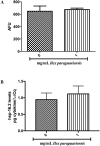Ilex paraguariensis modulates fat metabolism in Caenorhabditis elegans through purinergic system (ADOR-1) and nuclear hormone receptor (NHR-49) pathways
- PMID: 30252861
- PMCID: PMC6155532
- DOI: 10.1371/journal.pone.0204023
Ilex paraguariensis modulates fat metabolism in Caenorhabditis elegans through purinergic system (ADOR-1) and nuclear hormone receptor (NHR-49) pathways
Abstract
Ilex paraguariensis is a well-known plant that is widely consumed in South America, primarily as a drink called mate. Mate is described to have stimulant and medicinal properties. Considering the potential anti-lipid effects of I. paraguariensis infusion, we used an extract of this plant as a possible modulator of fat storage to control lipid metabolism in worms. Herein, the I. paraguariensis-dependent modulation of fat metabolism in Caenorhabditis elegans was investigated. C. elegans were treated with I. paraguariensis aqueous extract (1 mg/ml) from L1 larvae stage until adulthood, to simulate the primary form of consumption. Expression of adipocyte triglyceride lipase 1 (ATGL-1) and heat shock protein 16.2, lipid accumulation through C1-BODIPY-C12 (BODIPY) lipid staining, behavioral parameters, body length, total body energy expenditure and overall survival were analyzed. Total body energy expenditure was determined by the oxygen consumption rate in N2, nuclear hormone receptor knockout, nhr-49(nr2041), and adenosine receptor knockout, ador-1(ox489) strains. Ilex paraguariensis extract increased ATGL-1 expression 20.06% and decreased intestinal BODIPY fat staining 63.36%, compared with the respective control group, without affecting bacterial growth and energetic balance, while nhr-49(nr2041) and ador-1(ox489) strains blocked the worm fat loss. In addition, I. paraguariensis increased the oxygen consumption in N2 worms, but not in mutant strains, increased N2 worm survival following juglone exposure, and did not alter hsp-16.2 expression. We demonstrate for the first time that I. paraguariensis can decrease fat storage and increase body energy expenditure in worms. These effects depend on the purinergic system (ADOR-1) and NHR-49 pathways. Ilex paraguariensis upregulated the expression of ATGL-1 to modulate fat metabolism. Furthermore, our data corroborates with other studies that demonstrate that C. elegans is a useful tool for studies of fat metabolism and energy consumption.
Conflict of interest statement
The authors have declared that no competing interests exist.
Figures






References
-
- Debas HT, Laxminarayan R, Straus SE. Complementary and alternative medicine. 2006. - PubMed
-
- Mosimann AL, Wilhelm-Filho D, da Silva EL. Aqueous extract of Ilex paraguariensis attenuates the progression of atherosclerosis in cholesterol-fed rabbits. Biofactors. 2006;26(1):59–70. - PubMed
-
- Gonzalez A, Ferreira F, Vazquez A, Moyna P, Paz EA. Biological screening of Uruguayan medicinal plants. J Ethnopharmacol. 1993;39(3):217–20. - PubMed
Publication types
MeSH terms
Substances
Grants and funding
LinkOut - more resources
Full Text Sources
Other Literature Sources

